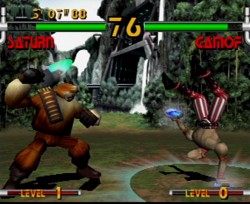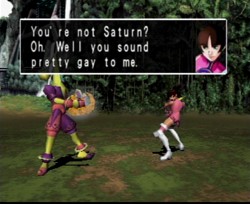| |
Plasma Sword
Better than MK Gold, but hardly a Soul Calibur... - Review By BenT
 About six or seven years ago, if you heard the name "Capcom", one thing would instantly pop into your mind, first and foremost - 2D fighting games. This was likely due to a little game called Street Fighter II, which took the industry by storm and caused a virtual revolution in arcades. After this initial success, Capcom saw its opportunity and rode the versus fighting wave, cranking out sequel after sequel. This strategy cemented their dominance in the fighting genre, with perhaps the only serious opposition coming from SNK. There was no doubt in anyone's mind, though - when it came to 2D fighting, Capcom was king. About six or seven years ago, if you heard the name "Capcom", one thing would instantly pop into your mind, first and foremost - 2D fighting games. This was likely due to a little game called Street Fighter II, which took the industry by storm and caused a virtual revolution in arcades. After this initial success, Capcom saw its opportunity and rode the versus fighting wave, cranking out sequel after sequel. This strategy cemented their dominance in the fighting genre, with perhaps the only serious opposition coming from SNK. There was no doubt in anyone's mind, though - when it came to 2D fighting, Capcom was king.
However, Capcom may have become a little too comfortable in its niche, because they failed to respond to the emergence and ensuing popularity of 3D polygonal fighters. It was 1996 before Capcom finally announced their first 3D fighter, the science-fiction themed Star Gladiator. (Check out this vintage press release!) Unfortunately, it was a case of too little too late, as the game had nothing on Sega's Virtua Fighter or Namco's Tekken. However, the hardware the game ran on allowed an easy home translation to the Playstation, and it got a better reception there. Still, Star Gladiator was hardly the smash hit Capcom may have hoped for, and their future forays into 3D fighting (Rival Schools series, Street Fighter EX series) seldom fared much better.
Finally, in 1998 Capcom created a sequel to their first 3D fighter, calling it, well.. Star Gladiator 2. (For foreign markets they got a bit more creative, changing it to Plasma Sword: Nightmare of Bilstein.) The game played similarly to the first, with the usual additions here and there and a slightly expanded cast. The game ran on Namco's rather outdated System 12 hardware, ala Tekken Tag Tournament and Soul Calibur, so it didn't really wow anyone from a technological standpoint. Still, seeing the first class home translations those games got, we should have high hopes for the Dreamcast version of Plasma Sword, right?
The Good

I really like the character designs, but they deserve a better game. |
Despite this being a 3D game, the interface and character selection graphics are all 2D, and herein lies the most interesting art in the game - the character portraits. This cast of characters is a well-designed bunch - Capcom's artists have come up with a great bunch of cool looking designs, and in 2D they look pretty darn spiffy. It's too bad Capcom didn't use this handsome cast for a CPS2 fighter - it could have been a nice change from their 2D mainstays Street Fighter and Darkstalkers (Vampire). Oh well. At least Plasma Sword's main character, Hayato, made it into Marvel Vs. Capcom 2.
The control is fine. Most special moves use the standard fireball and dragon punch motions that we've been using for years, so there's rarely a problem with botched input. Things just work. It's safe to say that by this point, Capcom has their fighting game controls down pat.

Standard in-game shot. Wee. |
The game plays ok - if you've played a 3D Capcom fighter in the past, this isn't much different. It would be safe to call this a 2.5D fighter, since the element of 3D movement doesn't come up too often. Like in Soul Calibur, you have a horizontal attack, a vertical attack, and a kick. Then there's the plasma button to assist with your plasma moves. One major change from the first Star Gladiator is that you must press backward to block, rather than using a dedicated block button. I much prefer this method as I think it fits the game's fireball/dragon punch control style better, making it feel like a Capcom game. The only other major gameplay system is the plasma meter. It functions like the super meters in other Capcom fighters, allowing you to pull off various plasma-powered special moves in exchange for draining one level of the meter. Some of these moves are downright wacky (Saturn's dancing move for example), while others are extremely cheap and skill-less button mashing fests (Hayato's "plasma sword"). It adds a bit of interest to the game, although I quickly grew weary of getting smacked by some of the game's cheaper attacks, which are easily abused.
The standard fighting game modes are present, being arcade, versus, team, and practice. They're all what you would expect. Compared to a Sega or Namco title the practice mode is extremely spartan, with the only changable option being to alter the behavior of the computer punching bag. However, there is a pyramid of your fighter's attack strings displayed in the corner, which is useful for learning your character. Special moves are nowhere to be found, though, so hold onto that manual or FAQ.
The Bad

A lot of the special moves are very imaginative, but an equal number are cheap as hell. |
The worst part about Plasma Sword is the fact that Capcom just didn't care. This is a carbon-copy of the arcade game, and little more. That might be alright in the case of a cutting-edge title like Dead or Alive 2, but here we have a game that was created on what is basically five year old hardware.
No attempts were made to bring the graphics up to Dreamcast standards, which leaves the visuals pretty hurting. In-game characters are low poly and animate jerkily. In fact, it's fair to say that the animation is downright poor. However, the game's worst graphical shortcoming are the stage backgrounds, which are simply flat bitmaps that give no sense of depth whatsoever. This was considered lame in Tekken 3, 
What can I say? This game has great dialogue. |
and is inexcusable on the Dreamcast. Further, the horizon line (and hence, background) is really rather close, which causes a bit of a claustrophobic feeling. I could go on, but I think it's clear: anyway you look at it, Plasma Sword is not a graphical tour-de-force.
Sound is weak as well. The music is as generic as you'd expect from Capcom, which is to say very. Nothing new here. Sound effects are also weak, especially when it comes to blocking. In fact, I thought the game was glitching for a while becuase the blocking sound is so broken sounding. Other than that you have your usual assortment of grunts, cries, and hits, sounding just a bit worse for wear.
Finally, the most laughable part of Plasma Sword is that half of the characters are out and out clones of each other. Do you like Saturn? Then you'll like Prince too, since he's simply Saturn with a different skin. Is Bilstein more your type? Then why not try Ghost Bilstein, who is Bilstein in a scary black color? You get the idea. Because of this blatant cloning, you can basically cut the number of unique-playing characters in half. When I first read the manual I thought it was odd that there were two characters per page, but only one list of moves. Now I know why, and find it appalling. This cloning is worse than Midway's palette-swapped MK ninjas, or even Tekken's highly derivative (yet still slightly unique) mid-bosses. Shame on Capcom for taking the easy, lazy route. If the cast of unique characters had been twice as large, it would have added somewhat to the title's gameplay value.
The Final Word
Despite the score, Plasma Sword is not a terrible game. Don't get me wrong; it's not great by any stretch of the imagination, but it's certainly a lot better than utter dreck like Time Killers and Criticom. Still, the bar has been raised by amazing home ports such as Soul Calibur and Tekken Tag Tournament, so a merely "arcade perfect" port of an extremely average game isn't enough to stay competitive on today's next generation systems. If Plasma Sword had appeared on the Playstation it would have fared a bit better, but as a Dreamcast title, there are better fighters to occupy your time.
Developer: Capcom
Publisher: Capcom
Genre: Fighting
Highs: Solid control, good character design, passable gameplay.
Lows: Sub-par graphics, generic music, lame sound effects, unbalanced moves, misleadingly small cast (due to blatant character cloning).
Other: 1-2 players, VMU Compatible (6 blocks), Jump Pack Compatible, Arcade Stick Compatible.
|
Final Score:

(out of a possible 10)
|
Visit this Game's Dreamcast Database Entry
Previous Reviews
Comments on this review? Mail Feedback.
|

